HIGHLIGHTS OF THE FLIGHTS
What is it like for a research test pilot to fly an X-15 airplane into unknown areas of speed and altitude? He arrives early in the morning, a good time for flight since the winds and temperature are lower at that time in this desert area. He goes to the physiological van at Edwards Air Force Base and there puts on his David Clark full-pressure
suit. He walks across the ramp to the airplanes, the B-52 and X-15. He climbs a large ladder to a platform next to the X-15, and then he enters the small X-15 cockpit. He prepares the airplane and himself for takeoff while the X-15 is attached to the B-52 mother plane.
The B-52 crew goes through a preflight list that includes the location, altitude, and velocity at which the X-15 was to be launched. They then start the engines and check that everything is okay with the pilot, who is captive in the X-15 under the wing. (All this was a much less severe routine than that required by the X-15 pilot in preparation for the flight, but their job to make sure the X-15 was safely launched was just as important.)
The B-52 takes off and climbs to altitude, about 45,000 feet. There the flight crew inside the B-52 prepares for the drop launch of the X-15, going through their checklist and topping off the liquid oxygen in the X-15, some of which has boiled off during the climb to launch altitude.
When all is ready, the B-52 drops the X-15, located underneath its right wing. The X-15 smoothly separates from the mother ship, usually with a roll to the right to compensate for the local airflow located under the right wing of the B-52. The X-15 pilot levels his airplane and lights up his engine. He accelerates away from the B-52 and, once clear, the pilot rotates his airplane to increase the angle of attack for climb to altitude.
Although the primary purpose of the X-15 was the acquisition of research data on the aerodynamics, thermodynamics, and flight dynamics of hypersonic flight, the quest for speed and altitude has been the driving force in the historical advancement of the airplane over the past 120 years. Therefore, obtaining maximum speed and maximum altitude was also important. However, the flight conditions required to obtain maximum speed are different than those to obtain maximum altitude.
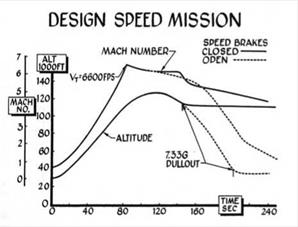 |
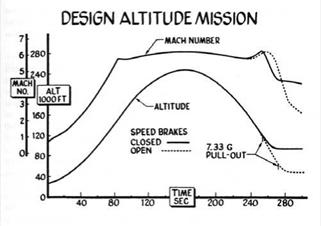 |
MAXIMUM SPEED
Here, the pilot continues his climb to altitude, then pushes over at zero lift until the airplane is in level flight at the desired altitude. He continues to fly at that altitude at full thrust until the maximum speed is obtained, which occurs when the fuel is used up. Zero lift means that the pilot adjusts the orientation of the airplane relative to the airflow ahead of the airplane (the angle of attack) so that the aerodynamic lift becomes zero, and he holds this until the X-15 is now moving in horizontal flight (level flight).
The airplane then starts to fall back to earth under the force of gravity, and it decelerates as the aerodynamic drag builds up at lower altitudes. During this return to earth, the airplane is in a steep glide, with a plan to reach an altitude of about 35,000 feet with a velocity of 290 to 350 miles per hour (called high key, which was the highest approach to the runway at Edwards Air Force Base). From there, he descends to an altitude of 18,000 feet, flying in the opposite direction of the landing runway (called low key on the flight trajectory). At this point, the airplane is about 4 miles from touchdown. The pilot continues in a 180-degree turn and then lands, probably at a speed of 200 miles per hour.
MAXIMUM ALTITUDE
After launch from the B-52, the X-15 continues to climb until the fuel is used up and then continues in an upward ballistic trajectory, reaching a maximum altitude determined by its kinetic energy at the point of engine burnout and the force of gravity. The airplane then begins to descend. The pilot then heads for home, reaches high key above Edward, descends, and lands as above. Because of the high altitude, the glide return is over a larger distance than the lower-altitude flights. For these flights, the airplane would be dropped at a greater distance from Edwards Air Force Base, sometimes as far as away as 300 miles, so that his glide ends at Edwards.
For most of the X-15 flights, the data gathering was done in the regions bounded by the maximum speed and the maximum altitude flights. The variation of Mach number and altitude during these flights is shown in the two Mach number/ altitude versus time-of-flight figures shown, one for a maximum speed flight and one for a maximum altitude flight.
The data obtained in the hypersonic region of these flights provided vital flight data points that were calibrated against analytical predictions and against wind tunnel data. The designing of aircraft

ROLLOUT FROM THE NORTH AMERICAN FACTORY
Arrival of the first X-15 to Edwards Air Force Base. USAF, Air Force Flight Test Center History Office, Edwards Air Force Base
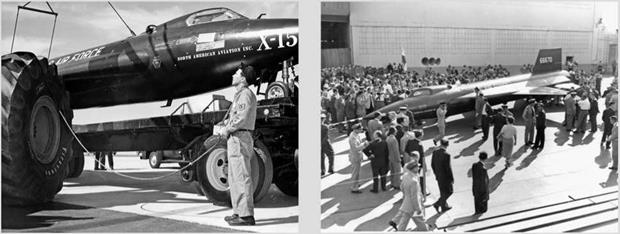
Unloading the X-15 upon arrival at Edwards Air Force Base. USAF, Air Force Flight Test Center History Office, Edwards Air Force Base
The welcoming crowd upon arrival of the X-15 to Edwards Air Force Base. USAF, Air Force Flight Test Center History Office, Edwards Air Force Base
 |
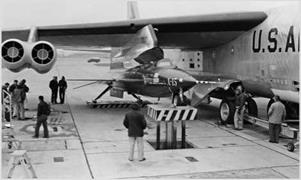 |
PREPARATION FOR FLIGHT-UNDER THE WING OF THE B-52
X-15 being mated to the B-52. USAF, Air Force Flight Test Center History Office, Edwards Air Force Base
|
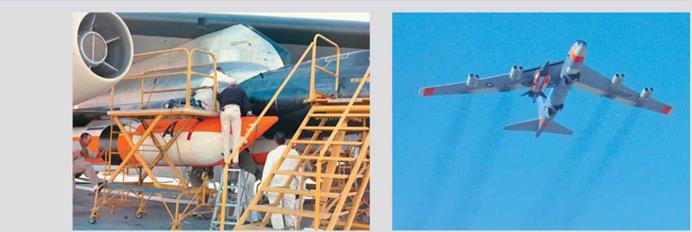
Detail of the mating of the X-15 with the B-52 for its first flight with external fuel tanks (empty), November 3, 1965. USAF, Air Force Flight Test Center History Office, Edwards Air Force Base
Takeoff of the B-52 with the X-15 with external tanks, November 3, 1965. USAF, Air Force Flight Test Center History Office, Edwards Air Force Base
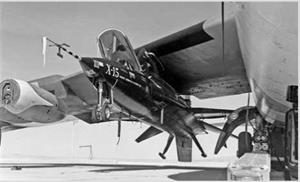
|
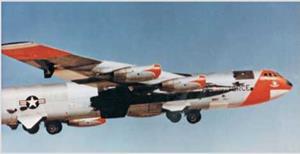
X-15 mated with the B-52 for one of its early contractor flights. USAF, Air Force Flight Test Center History Office, Edwards Air Force Base
Takeoff of the B-52 with the X-15 mounted under the wing. USAF, Air Force Flight Test Center History Office, Edwards Air Force Base
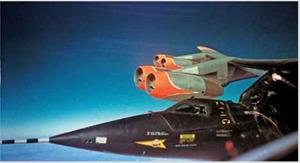 |
 |
LAUNCH
X-15 mounted under the wing of the B-52 mother ship at altitude. USAF, Air Force Flight Test Center History Office, Edwards Air Force Base
IN FLIGHT
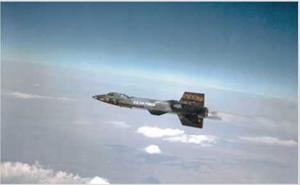

X-15 in flight after launch. USAF, Air Force Flight Test Center History Office, Edwards Air Force Base
LANDING ON LAKEBED AND RESTING ON
X-15 in flight. USAF, Air Force Flight Test Center History Office, Edwards Air Force Base
LAKEBED

 |
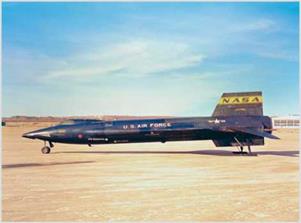 |
X-15 landing with the F-104 chase plane alongside. USAF, Air Force Flight Test Center History Office, Edwards Air Force Base
X-15 after landing. USAF, Air Force Flight Test Center History Office, Edwards Air Force Base
 |
to fly in these regions, as well as vehicles to return from space, could proceed with confidence by knowing what corrections to make to the analyses and wind tunnel data. This data gathering and its correlation to analysis and wind tunnel results was the purpose of the X-15 research airplane program.
On October 3, 1967, Pete Knight achieved the maximum Mach number for the X-15, and he did it flying the modified version of the X-15, the X-15-A2, with additional fuel in the extended fuel tanks and with extra external fuel tanks. The extra fuel allowed more full thrust time, totaling 141 seconds—50 seconds more than the basic X-15 Nos. 1 and 2. After being in the X-15 for more than an hour under the wing of the B-52 while on the ground, Knight performed the preflight checklist and was lifted when the B-52 took off at 1:20 p. m. They headed for Mud Lake, over which the B-52 dropped him an hour later.
It took two launch attempts before the drop actually worked. Knight stated later that he “reached up and hit the launch switch and immediately took my hand off to [go] back to the throttle and found that I had not gone anywhere. It did not launch.” [citation: Jenkins, X-15: Extending the Frontiers of Flight, NASA SP-2007-562, 1967, p. 459] A second attempt 2 minutes later resulted in a smooth release. Pete then accelerated and climbed at an angle of attack of 12 degrees (angle between the wing chord and the free-stream airflow direction) at high lift until he reached a climb angle (angle between the horizontal and the flight path) of 32 degrees. He leveled off at 102,100 feet and reached a speed of 6,600 feet per second (Mach 6.7). This speed remains the fastest for a manned-powered airplane forty-seven years later, with no competitor airplane in sight.
Then, some unpleasant excitement occurred after burnout. Pete performed some rudder pulses to get data with the yaw damper off. As he decelerated through M=5.5, the “Hot Peroxide” warning light came on. On this particular flight, the X-15 was carrying a dummy supersonic combustion ramjet engine (scramjet) below its fuselage as part of a NASA hypersonic propulsion project. This was not an operating engine; it was a dummy engine being carried under the X-15 to examine the aerodynamic characteristics of the engine shape in full-scale hypersonic flight. The warning was caused by the aerodynamic heating generated by the shock wave from the dummy scramjet impinging on the bottom surface of the X-15. It severely damaged the airplane. Pete jettisoned the remaining peroxide to prevent it from exploding. The dummy scramjet was externally mounted in anticipation of future experiments. Shock waves also impinged on the vertical tail, with some melting and skin rollback.
The hot-peroxide event distracted Knight from energy management of the X-15, and he arrived at high key at supersonic speed rather than the desired, slower, subsonic speed. With this airspeed, the X-15 had too much kinetic energy. Pete then tried to jettison the ramjet, but nothing seemed to happen. He dissipated the excess kinetic energy by flying past the landing site, allowing aerodynamic drag to slow the airplane, and then landed at the proper speed. The dummy ramjet didn’t release at once when jettisoned, and it was later located on the lakebed after some clever reasoning and analysis by Johnny Armstrong of the Flight Planning Group.
Joe Walker flew the maximum altitude flight on August 22, 1963. In his prior flight on July 19, 1963, the maximum altitude planned by NASA for that flight had been 315,000 feet, but he unintentionally overshot that mark and achieved an altitude of 347,800 feet, close to the maximum altitude of 360,000 feet that NASA was ultimately seeking for the X-15. The airplane could go over
400.0 feet, but there was concern about the reentry from that altitude. It was deemed difficult but possible for the pilot to make a successful reentry from there, but NASA set a limit at
400.0 feet. Because of the risks of reentry from higher altitudes, they set the flight at 360,000 feet to allow for the inaccuracies of the engine and the ability of the pilot to hold to the tight limits of controlling the angle of attack.
The flight path was selected, with climb angles and fuel cut-off that were calculated to achieve their goal. The engine thrust could vary from 57,000 pounds to 60,000 pounds, and a difference of 1,500 pounds would result in a 7,500-feet altitude change. One second in fuel cut-off time would result in a 4,000-foot altitude change, and if the climb angle were off by one degree, a 7,500-foot change in altitude would result. The planned maximum altitude of the flight was set at 360,000 feet because it allowed a factor of safety. If some of the slight variations in engine thrust, fuel cut-off time, and climb angle took place, the inadvertent increase in altitude would not take the X-15 to over 400,000, where reentry was more dangerous.
This flight was delayed for about two weeks because of weather and airplane APU problems. The actual launch went well, and Walker stayed close to the flight plan. The propellants were depleted at 176,000 feet at a speed of 5,600 feet per second. The airplane continued to soar upward on a ballistic trajectory to 354,200 feet—two minutes after fuel burnout. At that point, Walker and the X-15 were 67 miles high.
After reaching peak altitude, the airplane headed home, some 306 miles away, and was moving at 5,500 feet per second when it passed through 176,000 feet. This was a mirror image of

 |
its ballistic climb after fuel burnout. The pullout force at 5 g occurred at 95,000 feet, and the pilot maintained the high g pullout in order to level flight at 70,000 feet. The rest of the flight back to landing at Edwards Air Force Base was uneventful. The total time of flight was 11 minutes and 8 seconds. While 67 miles is well above the 50 miles required for the pilot to achieve official astronaut rating, it was not awarded to Joe Walker until forty-two years later, after he had died.
There was only one fatal accident during the whole X-15 flight-test program. On November 15, 1967, Michael Adams lost his life when a possible electrical disturbance affected his flight control
The Air Force pilots who flew the X-15 to altitudes above 50 miles all received Astronaut Wings, but NASA had decided not to give the same award to the civilian pilots who had made the same achievement. This caused controversy within the aerospace community. Finally, NASA reversed this policy, and in a ceremony on August 23,
2005, the three NASA pilots who flew the X-15 above 50 miles—William Dana, Jack McKay, and Joe Walker—were awarded Astronaut Wings.
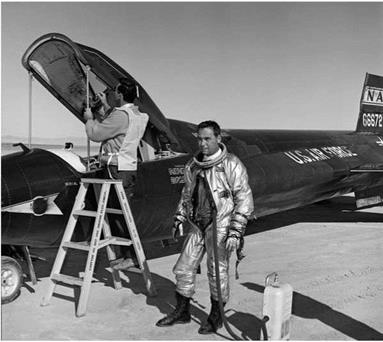 Only Bill Dana was alive at that time to receive the certificate. However, the families of McKay and Walker were present to receive the honor.
Only Bill Dana was alive at that time to receive the certificate. However, the families of McKay and Walker were present to receive the honor.

 |
|
 |
|
system. This, combined with his possible vertigo, caused his X-15 to go out of control and break up at an altitude of approximately 62,000 feet during descent and crash to the desert floor. This flight underscored the risk involved in such flight testing. The details of this flight are given in Chapter 5.










